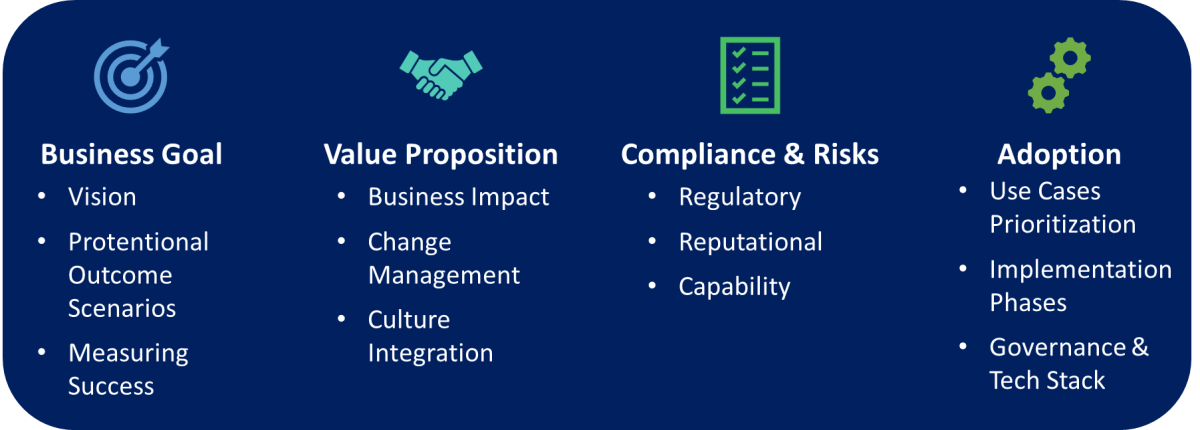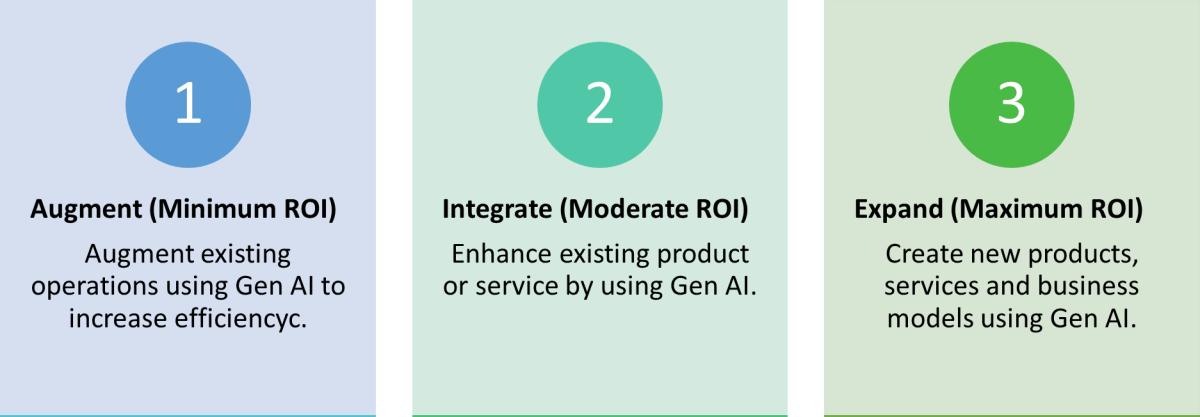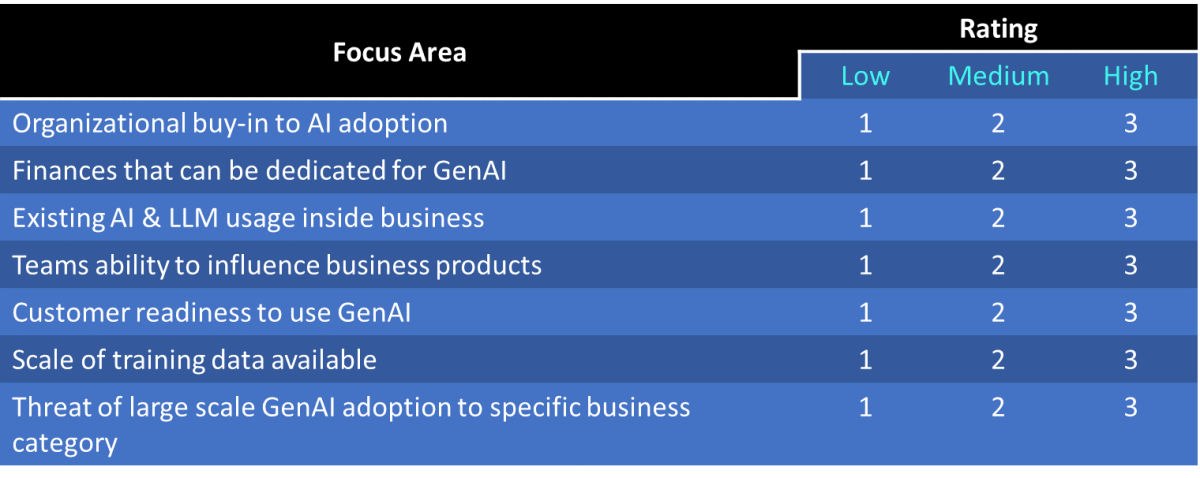
The Age of AI: Accelerate or Brake?
January 30, 2024
Menu Metamorphosis: The QR Code Revolution
February 1, 2024Approaching Generative AI Adoption : Navigating Business Transformation
Generative AI (GenAI) is anticipated to play a pivotal role in determining success or failure in the next five years for businesses, like previous technological shifts like Web 1.0 and native Mobile Apps. GenAI is poised to bring about significant disruption, reshaping various business facets.
As a recent and often misunderstood technology, many companies lack a comprehensive approach to adopting GenAI. Instead, they frequently engage in isolated use cases, capturing only partial benefits and overlooking the broader potential of this transformative technology. To unlock the full potential of GenAI, organizations must craft a deliberate approach that coordinates efforts across various departments, ensuring maximum impact. Proper planning is crucial to navigating workforce changes, managing risks, and fully harnessing the value that GenAI offers. According to McKinsey’s projections, if executed effectively, GenAI could contribute $3-5 trillion annually across global economies.
It’s important to note that there is no one-size-fits-all adoption roadmap for every business. Some enterprises may be ready to explore innovative ways of developing products, while others may prioritize automating and optimizing repetitive tasks to reduce costs. Therefore, a GenAI adoption should be tailored to address current challenges and align with the future direction of the company.
Building Blocks of GenAI Adoption Roadmap
By taking the time to construct a robust approach, companies can realize massive value while safely navigating risks and changes.

GenAI adoption requires goal oriented value proposition supported with regulatory and capability compliance and risk assessment achieved through prioritization of use cases and proper governance.
Evaluating Potential Opportunities
To seize the potential presented by GenAI, businesses should begin with an opportunity assessment.
- Identifying areas where GenAI can add value by mapping potential use cases aligned with key priorities, strengths, and challenges.
- Forming cross-functional teams to brainstorm possibilities across various departments like marketing, R&D, customer service, and IT is critical to ensure proposition is not in silo.
- Based on the assessment by the cross-functional teams, develop a list of potential value drivers, such as personalized advertising, accelerated coding, or customer data analysis.
- Prioritize opportunities based on criteria like value potential, time to realization, implementation complexity, and the availability of foundational assets.
- Prioritize quick wins and low hanging fruits initially, focusing on areas where GenAI can swiftly address urgent challenges.
Implementation Blueprint
After identifying potential opportunity areas, create a phased rollout plan throughout the enterprise. Ensure that this roadmap aligns with strategic priorities and effectively mitigates associated risks. Each initiative should have a designated target to be achieved, where the measured impact determines whether to expand, modify, or abandon the initiative. For instance, if a chatbot exhibits fragmented value, continue iterating before implementing companywide.
__________________________________________________________________________________
“It’s crucial for business leaders to align on a scorecard that monitors key pilot metrics and strategic objectives.”
_________________________________________________________________________________
It is critical to adopt an agile approach, involving the deployment of pilots, continuous refinement based on feedback, and iterative scaling. Striking the right balance between speed and caution is crucial – moving too slowly may result in missed value, while reckless haste increases risks. Establishing the optimal cadence is achievable through deliberate road mapping.
Strategic & Responsible Governance
A comprehensive GenAI adoption roadmap necessitates responsible governance and ensures alignment with business values. Governance encompasses model development, monitoring systems, and protocols outlining human oversight. Specifically, in scenarios where GenAI generates customer communications, safeguards must be implemented to prevent biased, illegal, or harmful content. The rollout plan should include human oversight and approval workflows. The governance should be embedded in every step of GenAI adoption including :-
- Model Development:
- Define ethical considerations and guidelines to guide the development process.
- Curate diverse and representative datasets to minimize biases and enhance the model’s ability to produce fair and inclusive outcomes.
- Monitoring Systems:
- Set up continuous monitoring systems to assess AI outputs in real-time, identifying and addressing any deviations from ethical standards promptly and establish clear performance metrics.
- Human Oversight Protocols:
- Integrate human oversight and approval workflows into the deployment plan, allowing experts to validate AI-generated contents.
- Conduct regular audits to ensure ongoing compliance with ethical guidelines and corporate values, making adjustments as needed.
- Risk Mitigation:
- Conduct thorough risk assessments to identify potential pitfalls and challenges focusing on areas such as bias, legality, and potential harm.
- Stakeholder Engagement:
- Foster transparent communication with stakeholders, keeping them informed about the ethical governance measures in place and seeking input to enhance accountability.
- Provide training to relevant teams and stakeholders to raise awareness about responsible AI practices and their role in ensuring ethical governance.
Workforce Changes
GenAI world is changing fast and it’s crucial to keep the workforce in the loop. Companies need to keep encouraging their teams to learn new skills and stay creative. Adobe, for example, started offering customized AI training to make sure their teams are well-prepared for the tech changes. Companies like Wipro are incentivizing GenAI skills. They’re providing training at different levels, making it easy for employees to boost their skills and earn some extra benefits.
_________________________________________________________________________________
“Moving too slowly may result in missed value, while reckless haste increases risks.”
_________________________________________________________________________________
While GenAI assumes repetitive tasks, employees can redirect their focus toward high-value work. However, achieving this shift requires meticulous planning for change management, comprehensive training, upskilling initiatives, and overall organizational transformation.
Capabilities and Risks
Crafting adoption roadmap will bring to light any gaps in capabilities that need attention, spanning technology, processes, and skills. Key areas worth investing in encompass data management, AI/ML Ops engineering, change management, performance metrics, and risk control.
In the realm of effective GenAI, well-organized data is paramount. Teams dedicated to data can design pipelines and establish quality assurance processes. Furthermore, crucial aspects like ethics and compliance safeguards require ongoing development.
To ensure a smooth integration of GenAI, change management resources play a vital role in supporting workers. Similarly, enhancing performance management processes becomes essential for tracking impact and guiding decision-making at each stage. This, in turn, facilitates data-driven decisions when scaling pilots.
Pilot Metrics and Tracking
Lastly, implementing an effective adoption approach necessitates robust tracking mechanisms. Essential performance indicators such as agent call time, sales conversion rates, or release frequency offer valuable insights into the journey toward intended goals.
Successful tracking relies on an initial investment in analytics instrumentation and establishing clear accountability. It’s crucial for business leaders to align on a scorecard that monitors key pilot metrics and strategic objectives.
Maintaining a clear view of outcomes allows organizations to fine-tune strategies and capitalize on successes. Continuous measurement of progress ensures strategic utilization of GenAI’s potential, preventing any missed opportunities.
Identifying the right GenAI approach
The right GenAI approach for business, team or startup depends on several factors – from organizational buy-in to define project spec & planning. GenAI adoption can be pursued in three modes as mentioned in graphic below:-

However, every business has its own internal dynamics, financial priorities and external factors that can play a pivotal role in adoption roadmap. The rubric below lists some key factors with high impact on GenAI adoption roadmap:-

The rubric can be used to grade the current standing of businesses and identify the suitable GenAI adoption mode, for example augmenting but not integrating or integrating but not quite ready to expand etc.

The GenAI era holds the promise of transforming various facets of business, demanding more than isolated use cases. To fully capitalize on its potential, organizations must adopt a deliberate adoption roadmap that coordinates efforts for maximum impact. A robust plan enables systematic identification of high-value opportunities, coordinated adoption across units, responsible governance, and continuous progress tracking. Proactive leadership commitment is essential, involving executives, innovators, product managers, and entrepreneurs. This commitment includes providing resources, communication, upskilling budgets, and change management to support employees in embracing AI-assisted workflows. Cross-functional collaboration ensures that GenAI pilots align with the overarching strategy, offering a strategic advantage when integrated with company-wide priorities.
About the writer: Dr. Usman Zia is an Assistant Professor at the School of Interdisciplinary Engineering and Sciences (SINES), National University of Sciences and Technology (NUST), Pakistan. His research interests are Generative AI, Large Language Models (LLM), Natural Language Processing (NLP), and Machine Learning. He has authored numerous publications on language generation and machine learning. As an AI enthusiast, he is actively involved in numerous projects related to on-premises domain specific LLMs, Retrieval Augmented Generation (RAG) and Information Retrieval.






